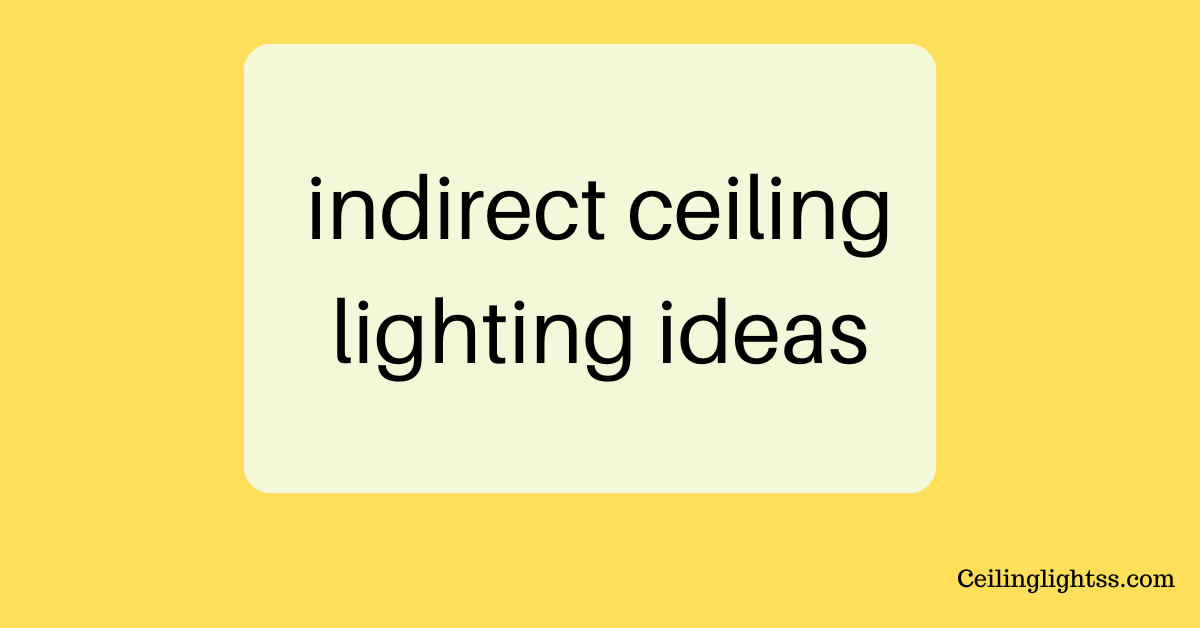The art of lighting has evolved dramatically over the years, and one of the most sophisticated and versatile options available today is indirect ceiling lighting. This modern lighting technique is a design marvel that not only illuminates a space but also enhances its aesthetics, creating a warm and inviting atmosphere. In this in-depth article, we will delve into the world of indirect ceiling lighting, exploring its benefits, various design options, and tips for implementation.
I. Understanding Indirect Ceiling Lighting
Indirect ceiling lighting refers to a lighting design where the light source is concealed, directing light upwards and reflecting it off ceilings, walls, or other surfaces. This indirect illumination method diffuses light gently throughout a space, eliminating harsh shadows and creating a soft, ambient glow. Here are some reasons why indirect ceiling lighting has gained popularity in contemporary interior design:
- Aesthetic Appeal: Indirect lighting adds a touch of elegance and sophistication to any room. It creates a cozy, inviting atmosphere that can transform a space into a serene haven.
- Versatility: This lighting technique is incredibly versatile, suitable for various settings, from residential homes to commercial spaces, and adaptable to different design styles, from modern to traditional.
- Reduced Glare: By bouncing light off surfaces, indirect lighting reduces glare and minimizes eye strain, making it ideal for areas where people need to concentrate or relax.
- Concealed Fixtures: Indirect lighting fixtures can be discreetly integrated into ceilings, walls, or architectural elements, allowing for a clean and uncluttered appearance.
II. Types of Indirect Ceiling Lighting
Indirect ceiling lighting can take on various forms, each offering unique aesthetics and ambiance. Here are some popular types:
- Cove Lighting: Cove lighting involves installing light fixtures in a recessed or concealed groove in the upper perimeter of a room. The light is directed upward, creating a gentle, uniform glow that washes over the ceiling and walls.
- Recessed Lighting: Recessed lights are set into the ceiling, casting their light upward and outward at an angle. This technique provides soft, even illumination and is often used in minimalist, contemporary designs.
- Tray Ceiling Lighting: Tray ceilings feature multiple tiers or levels, and these can be accentuated with recessed lighting or LED strips to highlight the architectural details and create a dramatic effect.
- Wall Washers: Wall washer lights are fixtures mounted on or near walls, designed to graze the wall with light, which then reflects onto the ceiling. This technique is excellent for emphasizing artwork or textured walls.
- Suspended Fixtures: Pendant lights or chandeliers with upward-facing bulbs can also contribute to indirect ceiling lighting when they are hung high enough to allow light to reflect off the ceiling.
III. Tips for Implementing Indirect Ceiling Lighting
- Plan Ahead: Careful planning is essential for successful indirect ceiling lighting. Consider the room’s purpose, the desired ambiance, and the existing architectural elements before choosing a lighting design.
- Layer Lighting: Combine indirect lighting with other types of lighting, such as task and accent lighting, to create a layered effect that caters to various needs and moods.
- Use Dimmers: Install dimmer switches to control the intensity of the indirect lighting, allowing you to adapt the atmosphere to different occasions and times of day.
- Select the Right Fixtures: Choose fixtures that complement the room’s style and the overall design concept. For example, modern spaces may benefit from sleek recessed lights, while traditional settings might favor decorative cove lighting.
- Pay Attention to Color Temperature: Consider the color temperature of the light source, as it can influence the mood of the room. Warmer temperatures (around 2700K) create a cozy atmosphere, while cooler temperatures (around 4000K) are more invigorating.
Indirect ceiling lighting is a design marvel that has the power to transform any space into a haven of elegance and warmth. Its versatility, aesthetic appeal, and ability to create a soft, inviting ambiance make it a favorite among interior designers and homeowners alike. By carefully planning your lighting design, selecting the right fixtures, and considering the room’s unique characteristics, you can harness the magic of indirect ceiling lighting to create a truly enchanting space. Whether you’re looking to update your home or enhance a commercial environment, indirect ceiling lighting is a timeless choice that can elevate your design to new heights.
What are some best ceiling lights for indirect lights
Choosing the best ceiling lights for indirect lighting depends on your specific needs, design preferences, and budget. Here are some popular options that work well for creating indirect lighting:
- Recessed Lighting: Recessed lights are a versatile choice for indirect lighting. Install them around the perimeter of the room, pointing the light toward the ceiling or walls to create a soft, ambient glow. Choose adjustable recessed fixtures to have more control over the light direction.
- LED Strips: LED strips are a fantastic choice for cove lighting, tray ceilings, or wall washing. They are flexible, energy-efficient, and can be installed in hidden spaces to provide a seamless and continuous source of soft, indirect light.
- Cove Lighting Fixtures: Specifically designed for cove lighting, these fixtures are available in various styles and sizes. They are great for creating a uniform, diffuse glow along the upper edges of walls and ceilings.
- Wall Washers: Wall washer fixtures are designed to wash walls with light, which then reflects onto the ceiling. They are ideal for highlighting artwork, architectural features, or textured walls. Wall washers come in various styles, from recessed to surface-mounted options.
- Pendant Lights and Chandeliers: While pendant lights and chandeliers are typically used for direct lighting, they can also contribute to indirect lighting when hung high enough to allow light to bounce off the ceiling. Choose fixtures with upward-facing bulbs for this purpose.
- Track Lighting: Track lighting systems can be used for both direct and indirect lighting. Adjustable track heads allow you to point the light toward walls or ceilings to create the desired indirect effect.
- Flush-Mount Fixtures: Some flush-mount fixtures are designed to provide indirect lighting by directing light upward and allowing it to diffuse off the ceiling. These fixtures often feature diffusers or shades that help soften the light.
- Linear Suspended Fixtures: Linear pendant lights or suspended fixtures can be used to create a modern and stylish indirect lighting effect. Install them parallel to the ceiling for a sleek and contemporary look.
- Up-Lighting Sconces: Wall-mounted up-lighting sconces are an excellent choice for adding indirect light to a room. They cast a soft, gentle light upward, creating a warm ambiance.
- Smart Lighting: Consider using smart lighting systems that allow you to adjust the intensity, color temperature, and even the color of the light to suit your preferences and needs. Many smart lighting options are compatible with voice control and smartphone apps.
When selecting the best ceiling lights for indirect lighting, consider factors like the room’s size, ceiling height, decor style, and the type of atmosphere you want to create. It’s also essential to work with a professional electrician or lighting designer to ensure that the installation is done correctly and safely, especially if it involves hidden wiring or complex fixtures.

